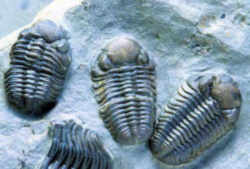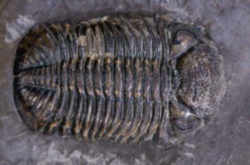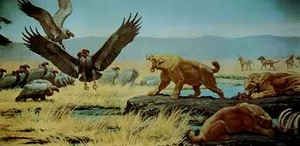Pennsylvania State Fossil
Trilobite

(Phacops rana)
Adopted on December 5, 1988.
The Trilobite, (Phacops rana,) was adopted on December 5, 1988. A water animal measuring just one to four inches, the (Phacops Rana) lived and left its mark Pennsylvania more than 250 million years ago. A science class of elementary school students brought this tiny invertebrate to the attention of the House of Representatives.
Pennsylvania State Fossil:Trilobite

Phacops rana is a fossil organism known as a trilobite (pronounced "tri-lobe-ite"). Trilobites are an extinct category of jointed-legged animals related to crabs, lobsters, shrimp, spiders, insects, and so on. This group of creatures, called arthropods, are among the most complex of all the animals without backbones and trilobites are no exception. They had well-developed nervous systems and large antennae. Trilobites had many appendages for swimming, walking, or feeding. Although these appendages are relatively rare in most groups of trilobite fossils. Phacops is one of four genera for which they are fairly well known and studied. Trilobites also had a hard outer skeleton composed of chitin, a complex organic protein, and the mineral apatite (calcium phosphate).
Many trilobites had large eyes. They are, in fact, the first organisms on earth known to have eyes. The trilobites had compound eyes, composed of many individual lenses, like those of insects. Trilobites, like other arthropods, had an external skeleton, called exoskeleton, composed of chitinous material. For the animal to grow, the exoskeleton had to be shed, and shed trilobite exoskeletons, or portions of them, are fossils that are relatively common.
Trilobites are a common fossil in many of the early to middle Paleozoic rocks of central Pennsylvania, i.e., rocks that are between 570 and 365 million years old. Complete fossil specimens are rare because the animals were composed of rigid outer skeletal segments joined by flexible organic connections that decayed on the death of the animal. Currents, scavengers, and molting all served to separate skeletal parts, which comprise the most common trilobite fossils in Pennsylvania. This common abundance of trilobite parts in the fossil record, in fact, was enhanced by the fact that the animals grew by casting off their outer skeleton in a series of molt stages. One animal probably produced ten to twelve potentially preservable skeletons in its lifetime.
An interest in trilobites is not restricted to scientists and geological dilettantes. They are prized by jewelry and curio collectors. This interest is a long standing one. Trilobites were found on necklaces belonging to the prehistoric inhabitants of 15,000 year old rock shelters of Europe. The Ute Indians of the western United States fashioned trilobites into amulets. The Ute name for these fossils was, "timpe khanitza pachavee" which means "little water but like stone house in."
Phacops rana is found in Pennsylvania's Devonian-age rocks (rocks between 405 and 365 million years old). A publically available location for finding fossil specimens of this fascinating creature are described in Pennsylvania Trail of Geology, Park Guide #16.
THE GENERAL ASSEMBLY OF PENNSYLVANIA
HOUSE BILL
No. 2171 Session of 1988
INTRODUCED BY BURNS, FEBRUARY 8, 1988
REFERRED TO COMMITTEE ON CONSERVATION, FEBRUARY 8, 1988
AN ACT
Designating the Phacops rana, a trilobite, as the official State fossil of the Commonwealth of Pennsylvania.
The General Assembly of the Commonwealth of Pennsylvania hereby enacts as follows:
Section 1. Official State fossil.
Phacops rana is a specific type of trilobite, a small sea creature. Trilobites were rulers of the sea during the Cambrian Period, 515 to 600 million
years ago. Trilobites are so named because their bodies are divided lengthwise into three parts or "lobes." Phacops rana means "frog eyes" because
of the large holes for eyes on the fossil. Fossils of Phacops rana are found in many parts of Pennsylvania, and, therefore, the Phacops rana is selected,
designated and adopted as the official State fossilof the Commonwealth of Pennsylvania.
Section 2. Effective date.
This act shall take effect immediately.
The Pennsylvania Statutes
The law designating the trilobite as the official Pennsylvania state fossil is found in Purdon's Pennsylvania Statutes and Consolidated Statutes, Title 71 (P.S. State Government) Part 1 (The Administrative Codes and Related Provisions) Chapter 6 (Provisions Similar or Closely Related to Provisions of the Administrative Code - Secretary and Department of Internal Affairs - State Emblems Section 1010.3
Title 71 P.S. State Government
I. The Administrative Codes and Related Provisions
Chapter 6. Provisions Similar or Closely Related to Provisions of the Administrative Code
Secretary and Department of Internal Affairs
State Emblems
§ 1010.3. Official state fossil
Phacops rana is a specific type of trilobite, a small sea creature. Trilobites were rulers of the sea during the Cambrian Period, 515 to 600 million
years ago. Trilobites are so named because their bodies are divided lengthwise into three parts or "lobes." Phacops rana means "frog
eyes" because of the large holes for eyes on the fossil. Fossils of Phacops rana are found in many parts of Pennsylvania, and, therefore, the
Phacops rana is selected, designated and adopted as the official State fossil of the Commonwealth of Pennsylvania.
CREDIT(S)
1988, Dec. 5, P.L. 1113, No. 138, § 1, imd. effective.
HISTORICAL AND STATUTORY NOTES
1990 Main Volume
Title of Act:
An Act designating the Phacops rana, a trilobite, as the official State fossil of the Commonwealth of Pennsylvania. 1988, Dec. 5, P.L. 1113, No. 138, §
1, imd. effective.
71 P.S. § 1010.3, PA ST 71 P.S. § 1010.3
Taxonomic Hierarchy: Trilobite
Kingdom: AnimaliaPhylum: Arthropoda
Class: Trilobita
Order: Phacopida
Family: Phacopidae
Genus: Phacops
Species: P. rana
Binomial name: Phacops rana (Green, 1832)
subspecies
P. rana rana
P. rana africana Burton & Eldredge, 1974
P. rana crassituberculata Stumm, 1953
P. rana milleri Stewart, 1927
P. rana norwoodiensis Stumm, 1953
P. rana paucituberculata Eldredge, 1972
P. rana tindoufensis Burton & Eldredge, 1974

Some states that lack a "state fossil" have nevertheless singled out a fossil for formal designation such as a state dinosaur, rock, gem or stone.







